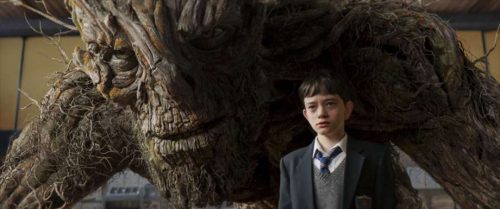
Spanish director J.A. Bayona returns with a griping story of a young boy dealing with the illness of his mother. The simple sounding story takes a twist in “A Monster Calls,” as the boy seeks help of a tree monster to cope with his mother’s terminal illness.
The film features veteran actors like Sigourney Weaver as the grandma and Liam Neeson as the Monster, along with newcomer Lewis MacDougall as Conor and Felicity Jones as his dying mother. Bayona directs this powerful ensemble while using spell bounding visuals to help create an honest look at dealing with some of life’s hardest issues.
Based on the award-winning children’s fantasy novel of the same name, the author Patrick Ness returned to pen the screenplay.
Bayona’s directorial debut was the 2007 horror thriller “The Orphanage.” His sophomore follow up was the heartbreaking tsunami disaster drama “The Impossible”. Bayona is now slated to direct the upcoming untitled Jurassic World sequel which will be released in 2018.
The DePaulia had the chance to speak with Bayona over the phone on the balance between the visual effects and griping source material.
DePaulia: The film is about truth telling and learning about life, can you share one truth that you learned through the film directing the story of a young boy dealing with the illness of his mother?
Bayona: I think somehow, one of the things that I love about the book is how it’s a great fantasy that talks about how we need fantasy to understand reality. And by doing so, it’s very interesting the way Patrick Ness separates reality from the truth. I think reality is all about information, and information is not knowledge, I think we get the knowledge from the stories.
Bayona: We get the knowledge from fiction. I think in that sense, I felt the same during the making of the film, the same in Conor. He needs to find the truth and express the truth as loud as he can. And I think as a filmmaker, you need to do the same and I realized that, by doing the film, that I had to do the story on my own. I had to find verisimilitude between Conor and myself. And try to see, what was behind the story, what was the reason behind the emotion I felt the first time I read the book.
DePaulia: This film balances the use of captivating visuals along with the drama of the real, a very real perspective of life. Now how was it balancing the two together to help tell this very honest story?
Bayona: I mean exactly the same way, I was telling you that, how we tell about the need of fantasy to understand reality, we need to define what was the reality and the fantasy of the story. We need to recreate it in both worlds. So one thing that we try to do is approach reality with a little sense of sophistication, I think reality is not 100% real.
Bayona: You cannot find cellular phones – it’s a little suspended in time – the reality of the film. And at the same time the fantasy is very grounded, all the elements of the fantasy are taken from the real world. By doing so, I was trying to find a way of blending in a very natural way the world of fantasy and the idea of reality. I think somehow I always try to tell that in a visual way. If you take a look at the film very closely, you will see how many frames, how many doors, how many windows separate the world of Conor from the world of the adults. Or the world of the fantasy from the world of reality. In other words, like a way of trying to find or the intention of trying to find a way of express that idea in a visual way.

